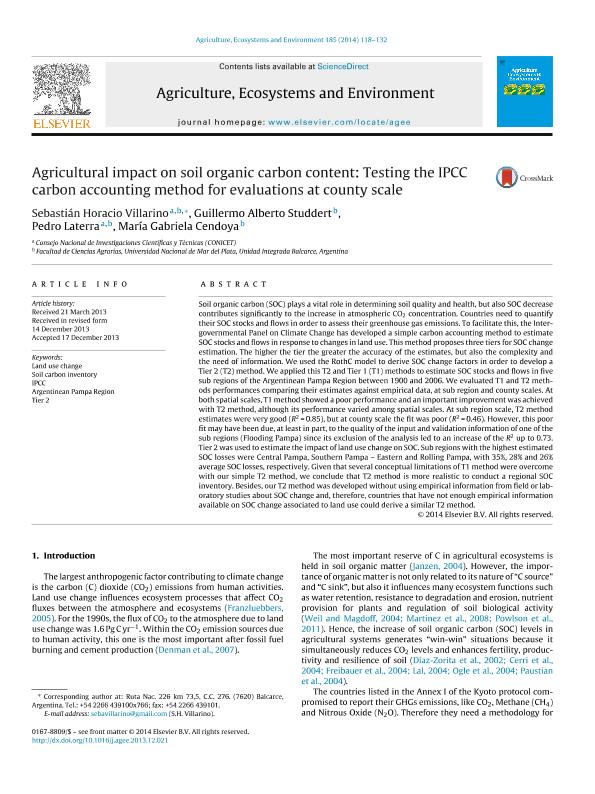Mostrar el registro sencillo del ítem
dc.contributor.author
Villarino, Sebastián Horacio

dc.contributor.author
Studdert, Guillermo Alberto

dc.contributor.author
Laterra, Pedro

dc.contributor.author
Cendoya, María Gabriela
dc.date.available
2017-10-02T18:40:05Z
dc.date.issued
2014-03-01
dc.identifier.citation
Villarino, Sebastián Horacio; Studdert, Guillermo Alberto; Laterra, Pedro; Cendoya, María Gabriela; Agricultural impact on soil organic carbon content: Testing the IPCC carbon accounting method for evaluations at county scale; Elsevier Science; Agriculture, Ecosystems and Environment; 185; 1-3-2014; 118-132
dc.identifier.issn
0167-8809
dc.identifier.uri
http://hdl.handle.net/11336/25626
dc.description.abstract
Soil organic carbon (SOC) plays a vital role in determining soil quality and health, but also SOC decrease contributes significantly to the increase in atmospheric CO2 concentration. Countries need to quantify their SOC stocks and flows in order to assess their greenhouse gas emissions. To facilitate this, the Intergovernmental Panel on Climate Change has developed a simple carbon accounting method to estimate SOC stocks and flows in response to changes in land use. This method proposes three tiers for SOC change estimation. The higher the tier the greater the accuracy of the estimates, but also the complexity and the need of information. We used the RothC model to derive SOC change factors in order to develop a Tier 2 (T2) method. We applied this T2 and Tier 1 (T1) methods to estimate SOC stocks and flows in five sub regions of the Argentinean Pampa Region between 1900 and 2006. We evaluated T1 and T2 methods performances comparing their estimates against empirical data, at sub region and county scales. At both spatial scales, T1 method showed a poor performance and an important improvement was achieved with T2 method, although its performance varied among spatial scales. At sub region scale, T2 method estimates were very good (R2 = 0.85), but at county scale the fit was poor (R2 = 0.46). However, this poor fit may have been due, at least in part, to the quality of the input and validation information of one of the sub regions (Flooding Pampa) since its exclusion of the analysis led to an increase of the R2 up to 0.73. Tier 2 was used to estimate the impact of land use change on SOC. Sub regions with the highest estimated SOC losses were Central Pampa, Southern Pampa – Eastern and Rolling Pampa, with 35%, 28% and 26% average SOC losses, respectively. Given that several conceptual limitations of T1 method were overcome with our simple T2 method, we conclude that T2 method is more realistic to conduct a regional SOC inventory. Besides, our T2 method was developed without using empirical information from field or laboratory studies about SOC change and, therefore, countries that have not enough empirical information available on SOC change associated to land use could derive a similar T2 method.
dc.format
application/pdf
dc.language.iso
eng
dc.publisher
Elsevier Science

dc.rights
info:eu-repo/semantics/openAccess
dc.rights.uri
https://creativecommons.org/licenses/by-nc-sa/2.5/ar/
dc.subject
Land Use Change
dc.subject
Soil Carbon Inventory
dc.subject
Ipcc
dc.subject
Argentinean Pampa Region
dc.subject
Tier 2
dc.subject.classification
Agricultura

dc.subject.classification
Agricultura, Silvicultura y Pesca

dc.subject.classification
CIENCIAS AGRÍCOLAS

dc.title
Agricultural impact on soil organic carbon content: Testing the IPCC carbon accounting method for evaluations at county scale
dc.type
info:eu-repo/semantics/article
dc.type
info:ar-repo/semantics/artículo
dc.type
info:eu-repo/semantics/publishedVersion
dc.date.updated
2017-09-29T14:43:38Z
dc.journal.volume
185
dc.journal.pagination
118-132
dc.journal.pais
Países Bajos

dc.journal.ciudad
Amsterdam
dc.description.fil
Fil: Villarino, Sebastián Horacio. Consejo Nacional de Investigaciones Científicas y Técnicas. Centro Científico Tecnológico Conicet - Mar del Plata; Argentina. Universidad Nacional de Mar del Plata. Facultad de Ciencias Agrarias; Argentina
dc.description.fil
Fil: Studdert, Guillermo Alberto. Consejo Nacional de Investigaciones Científicas y Técnicas. Centro Científico Tecnológico Conicet - Mar del Plata; Argentina. Universidad Nacional de Mar del Plata. Facultad de Ciencias Agrarias; Argentina
dc.description.fil
Fil: Laterra, Pedro. Consejo Nacional de Investigaciones Científicas y Técnicas. Centro Científico Tecnológico Conicet - Mar del Plata; Argentina. Universidad Nacional de Mar del Plata. Facultad de Ciencias Agrarias; Argentina
dc.description.fil
Fil: Cendoya, María Gabriela. Universidad Nacional de Mar del Plata. Facultad de Ciencias Agrarias; Argentina
dc.journal.title
Agriculture, Ecosystems and Environment

dc.relation.alternativeid
info:eu-repo/semantics/altIdentifier/doi/http://dx.doi.org/10.1016/j.agee.2013.12.021
dc.relation.alternativeid
info:eu-repo/semantics/altIdentifier/url/http://www.sciencedirect.com/science/article/pii/S016788091300443X
Archivos asociados
